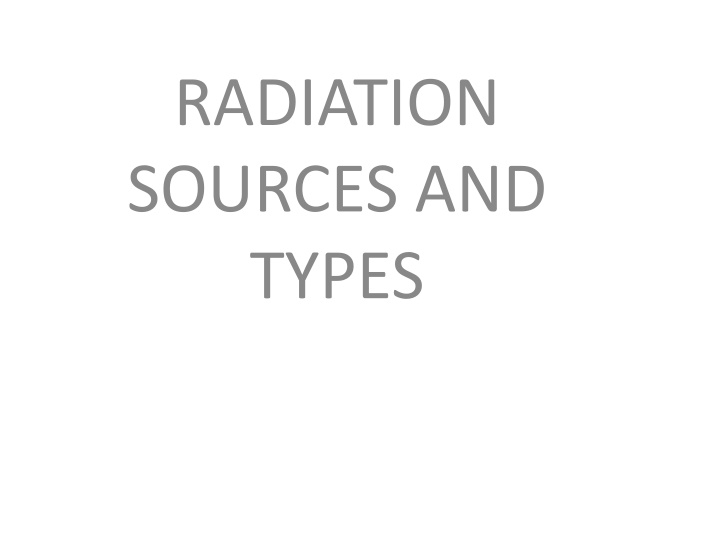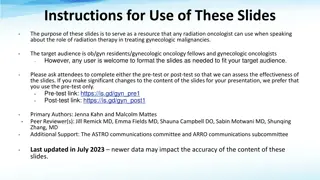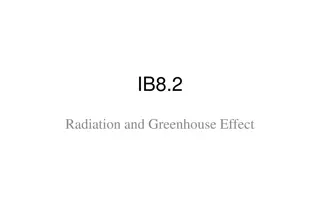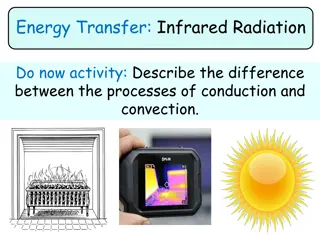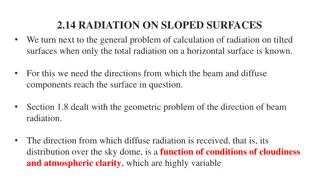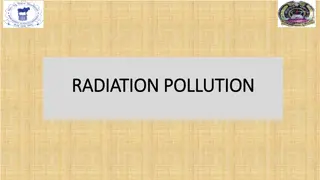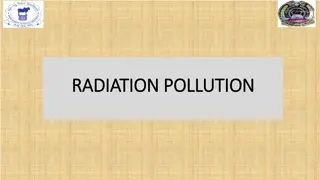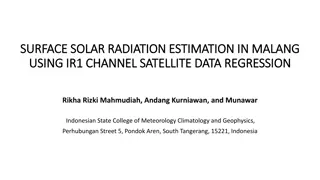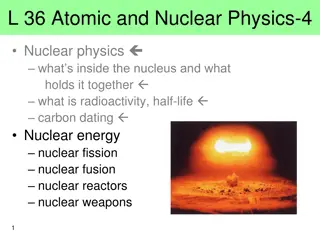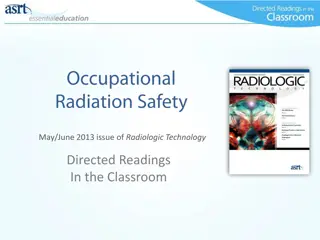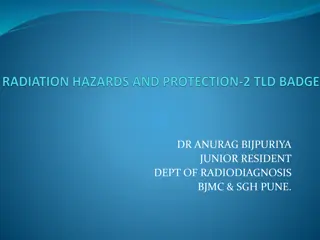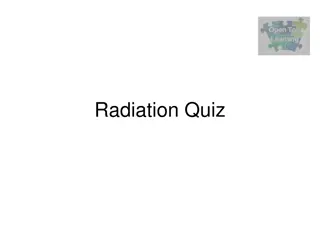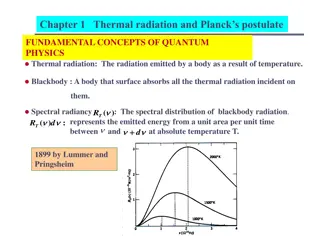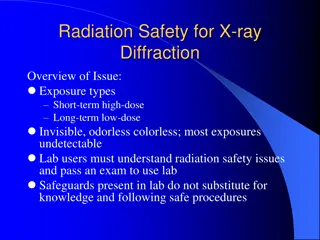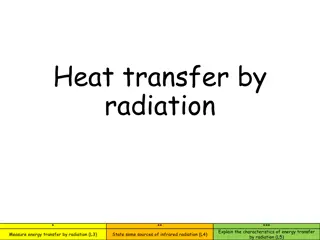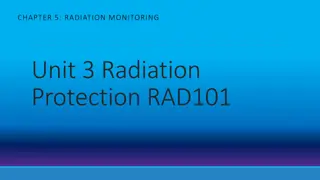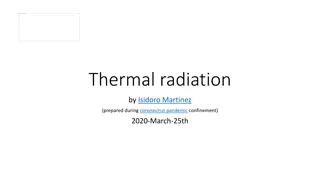Radiation Sources and Types
Radiation comes in various forms such as electromagnetic radiation, non-ionizing radiation, ionizing atomic particle radiation, X-rays, gamma rays, cosmic rays, and more. It is important to be aware of common sources like television, natural gas, and consumer products, which contribute to our daily exposure levels. Despite being exposed to radiation from everyday items, the risks are generally low and monitored for safety.
Download Presentation

Please find below an Image/Link to download the presentation.
The content on the website is provided AS IS for your information and personal use only. It may not be sold, licensed, or shared on other websites without obtaining consent from the author.If you encounter any issues during the download, it is possible that the publisher has removed the file from their server.
You are allowed to download the files provided on this website for personal or commercial use, subject to the condition that they are used lawfully. All files are the property of their respective owners.
The content on the website is provided AS IS for your information and personal use only. It may not be sold, licensed, or shared on other websites without obtaining consent from the author.
E N D
Presentation Transcript
RADIATION SOURCES AND TYPES
Radiation: is a form of energy carried by waves or stream of SOME TYPES OF RADIATIONS Electromagnetic radiation: The propagation of wave-like energy (without mass) through space or matter. The energy that is propagated is accompanied by oscillating electric and magnetic fields positioned at right angles to one another. 1-NON-IONIZING ELECTROMAGNETIC RADIATION RADIO MICROWAVES INFRA RED (HEAT) RED ORANGE YELLOW VISIBLE LIGHT (COLOR) GREEN BLUE VIOLET ULTRA VIOLET
X-RAYS GAMMA RAYS COSMIC RAYS 3-IONIZING ATOMIC PARTICLE RADIATION BETA RAYS Are fast moving electrons emitted from the nucleus of radioactive atoms. ALPHA RAYS Are emitted from the nuclei of heavy metal and exits as two protons and neutrons, without electrons. NEUTRONS Are accelerated particles with a mass of one and no electrical charge.
Television Dose: 1 mrem per year The average American watches about 4.5 hours of TV per day, acquiring 1 mrem of X-ray radiation per year from the machine s electric conductivity. TV sets and computer monitors that contain a cathode ray tube are capable of creating low-level X-rays, but the FDA requires all TV sets sold in the U.S. to be tested to make sure they do not exceed a safe level of X-ray emission. Flat-screen TVs and computers don t use cathode ray tubes, so they don t produce X-rays.
Natural gas Dose: 9 mrem per year Natural gas used for cooking, heating, and other purposes may up your exposure to radiation. But, again, the amounts tend to be so small that they won t harm your health.
Consumer products Dose: 11 mrem per year Cell phones, fluorescent lamps, watches, clocks, televisions, computers, and even ceramics and glass all emit some form of radiation, but at low enough rates that they have no known effect on your health. Cell phones, in particular, give off radio frequency (RF) waves that aren t as strong as X-rays, and while they might warm your cheek, the RF waves are at a low enough level that they do not damage tissue.
Cigarette smoking Dose: 1,300 mrem per year The 20% of Americans (about 43 million) who smoke are increasing more than just their risk of lung cancer, heart disease, and stroke. They inhale small amounts of radioactive material from both natural sources and the fertilizer used on the tobacco plants each time they take a puff. And tar from tobacco smoke traps some of these materials, in particular lead 210 and polonium 210, in their lung passages.
Soil Dose: 35 mrem per year Radioactive particles (radionuclides) in soil are either remaining from the Earth s original crust, introduced by cosmic radiation, or absorbed from man- made releases (such as nuclear power plant disasters like the one in Japan and fallout from nuclear weapons testing). Some of these radionuclides end up getting released from the soil as gas that we inhale, while others get taken up in water and plants. Although high levels of radionuclides in the soil can contaminate water and food, a number of agencies, including the EPA, regularly test supplies for radioactivity.
Drinking water Dose: 5 mrem per year It s no surprise that sources of drinking water in the U.S. contain low levels of radiation. It comes from rivers and lakes (if you live in an urban area) or wells (if you live in a rural area) where it can pick up radiation from natural sources like rocks and soil. Bodies of water that are near nuclear power plants are vulnerable to contamination with radioactive waste water, and are subject to extensive monitoring by the Environmental Protection Agency (EPA) to ensure these man-made sources of radiation do not surpass 4 mrem per year. 100 g of Brazil nuts per week=annual dose 0.2 msv
Radon Dose: 200 mrem per year Radon is a radioactive gas that you can t see or smell, but it may be in your home. It often creeps in through the floor or walls from natural decay of uranium in the ground, and gets trapped within the building; it can also be present in construction materials. In addition to breathing radon, you may be swallowing it in water or as dust particles. Next to smoking, radon is the second leading cause of lung cancer in the U.S.
Plane travel Dose: 2 3 mrem for a transcontinental flight Cosmic radiation comes from outer space and accounts for about 5% of background radiation exposure in the U.S. The atmosphere protects us from this radiation, so it makes sense that our exposure amplifies when we fly on a commercial airplane. For most people, plane travel is not a significant source of radiation, but pilots, flight attendants, and other frequent fliers can absorb up to 200 mrem per year, according to the EPA.
The new full-body X-ray scanners in airports are another source of radiation, but the exposure is negligible about 0.01 mrem per 3-second screening.
Medical imaging Dose: 10 to 1,000 mrem per screening Many imaging techniques to diagnose medical conditions use radiation, but the dose varies widely. Chest X-rays and dental X-rays deliver about 10 mrem, while mammograms (another form of X-ray) deliver about 138 per image. CT scans can have as many as 1,000 mrem per scan. "Outside of ordinary background radiation, the most common cause of exposure in the U.S. is from medical sources," Frey says. "But as long as there is a good reason for that procedure, the benefits will exceed the risks."
